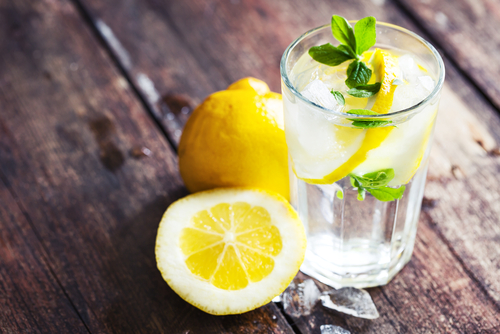“Water is The Driving Force of All Nature.”
This quote from Leonardo Da Vinci is one that I honor to be a fundamental truth. It is my personal opinion that the majority of people overlook the power, energy and love that water possesses. How amazing is it that 2 hydrogen and 1 oxygen put together to form one molecule of water can generate so much power and life. Water is the primary component of all of our bodily fluids – our blood, lymph, digestive juices, urine, tears and sweat. Additionally water is involved in almost every bodily function: circulation, digestion, absorption, and elimination are just a few of the many.
We know that water has the unsurpassed ability to heal, but not all water is created equal. On average, we need around 12 cups worth of water each day to stay hydrated, but the quality of water that we drink plays a crucial in our bodies health. It is important that we understand the detrimental effect that toxins within our water can have on our bodies. Choosing a clean source of drinking water is essential.The majority of people believe that the water we are getting from our taps within our homes are good clean sources of water, this is not always the case.
While our water sources are cleaner that the majority of the worlds we are still being exposed to
- Toxic substances that have accidentally found their way into soil and groundwater.
- Substances that have been put there intentionally.
The Environmental Protection Agency (EPA) monitors close to 80 toxic substances that find their way into our drinking water on a daily basis. These include but are not limited to things like chlorination by-products, heavy metals, pesticides, medications and plastics – sadly the list goes on and on.
What makes this matter even more difficult to deal with is the toxic load that our water contains is determined by a few things
- Where you are living
- Manufacturing and other pollution related activity that is taking place where you live.
With the amount of different toxic combinations within our water in a specific area it is imperative that we know what is in our water, and what our options are to further purify that water.
As we know water purification plants take large steps to minimize toxins. However, even when this is happening toxic compounds can still be present at potentially high levels that can damage our health. Toxic substances found in municipal drinking water across the United States have been indirectly linked to many chronic, degenerative diseases. While our drinking water does not pose an immediate health risk, it is still unknown what small, consistent exposures to these chemicals over a long period can be doing to our families and children.
So the questions remains,
How do we make our tap water safe to drink?
Most of the tap water that we consume originates from groundwater or surface reservoirs. The water from these sources goes through local treatment plants that may consist of a process of settling tanks, filtration through sand and gravel and then the use of chemicals to clean the remaining water so that it is fit for human consumption.
In 2002 the Environmental Working Group conducted a study on tap water quality in 42 states. They discovered repeated violations of primary drinking water standards. Among their findings more than 16 million people in 1,258 communities had been served tap water containing chlorination by products (like chloramines or THM) at level exceeding the MCLs for 12 consecutive months. In the case of some contaminants, like THM levels found in tap water were more than 5 times the maximum allowable level.
Chlorination by-products are not all of our worries, we as a country being exposed to things such as toxic fertilizers, lead, radon, nitrates, mercury, arsenic and fluoride among many others. So what are our options for best filtering our water further? As a mother of 4 small children this is very important to me. The list of literature and research, contaminates and solutions are enough to make any normal persons head spin. For the purpose of this blog we will discuss 3 of the more effective home water treatment systems. Please know as stated previously that this subject is going to take some individualized studying as not everyone’s tap water is created equal. You much look at what your water contains and then choose what system will be right for you based on those results. .
The three most effective water home treatments systems include
- Solid Carbon Block Filters
- Reverse Osmosis
- Distillation
All three systems will remove chlorine, ( although when looking at the RO system it is the pre-filter that does this), bacteria, metals, and chemicals.
Solid Block Carbon Filter
Solid block carbon filters work by removing most chemicals by absorption. This works by electromagnetically attracting the chemicals to the block itself. Chemicals removed this way usually include chloramines, lead, mercury, MTBE, PCBs, toxaphene and VOCs. These filters remove the unpleasant appearance, odor and taste of water by cleaning it of bacteria, parasites, most viruses, chlorine and the heavier minerals. While carbon is best at removing organic chemicals and chlorine it is not perfect for all micro organisms and metals. These systems will filter out any particles or organisms over 0.04 microns (this may change depending on what size of filter you have).
Reverse Osmosis
RO Systems work by tap water (being under pressure) flowing through special membranes with microporous holes the size of water molecules. These pores allow water molecules to pass through while rejecting the larger inorganic and organic matter. RO filters can remove particles as small as 0.009 micron- this is about 100 times smaller than what the carbon filters are capable of. RO units usually have 2 or 3 filtering mechanisms. With this system in place, nearly 100% of the organic material is removed along with most of the minerals. For the RO systems to be very effective they also require carbon block prefilters because of the free chlorine in tap water. This filter is in place to remove the chlorine before it gets to the other membranes so as not to deteriorate them. These systems are energy efficient, but they are not water efficient. Waste from these units can run between 2 and 30 gallons a day. This system also takes much longer for water production. These units may not clear all bacteria and chemicals, but the addition of carbon filtration makes them very efficient. However, because RO systems remove almost all of the minerals found in our water I advise adding these face minerals back in once the water is filtered.
Distillation
The distillation process works by vaporizing water in one chamber and then condensing it into liquid in a separate chamber. This system of purification removes most chemicals, minerals, and organisms from the water. VOCs that have a higher boiling point than water will not be removed however (because of this distilled water should be preceded by a carbon filter). As with the RO system this form of filtration removes all minerals and it is also recommended to add minerals back into the water once it is distilled.
There is much discussion if demineralized water should be consumed on a consistent basis. It is my belief that when we are filtering our water we should be reintroducing the naturally occurring minerals to our water once filtration is complete.
Below is a chart that shows what contents these specific filtration systems will work to eliminate. This chart also takes into consideration the energy usage as well as water waste that goes along with utilizing these systems.

Ultimately water is the substance that we need most. Because good drinking water is imperative to our health, we should know what the water we drink contains. Water contamination is inescapable but choosing a good filter for your home can dramatically decrease the toxins that we are exposed to. Every household, city and state are going to have different toxins within their water. It is up to you to get your water tested and then decide what filter works best for you and your family. It is important to follow usage instructions with these systems closely and make sure that you are changing the filters as needed. When taking these steps we can rest knowing that we are consuming clean water that is capable of miraculous things within us.
*********************************************************************************************
To give you an idea of what this looks like at my house: My family and I have chosen to have a Reverse Osmosis with a carbon pre filter under our kitchen sink. We specifically use this system for our drinking water (we have mineral pacts that we add to our water), washing our food,and cooking. We did not choose a Reverse Osmosis system for our whole house because of the amount of water waste that takes place. This system is economical, although it does cost more than just tap water – the trade for clean water is worth it. For the rest of our house we use shower filters to remove the chlorine.
Thanks for reading!
Alisha


